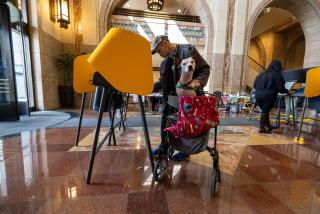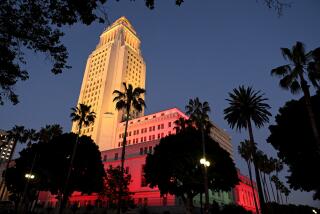The Davids Take Bureaucratic Goliath by Surprise
The newborn system of neighborhood councils in Los Angeles looks disorganized. But let’s not rush in to fix it yet.
There have been plenty of problems. Ballots were improperly copied (and there were 135 voters too many) at the Chinatown neighborhood council election last year, and stories of voting improprieties in other council elections have surfaced as well. Boundary disputes broke out downtown, in Glassell Park and elsewhere as competing organizers jostled for turf -- and some city funding -- by creatively defining their neighborhood borders. (Unfortunately, no one at City Hall knows where one neighborhood begins and another ends in fluid L.A., leading to accusations of constituent poaching.)
Some council organizers have looked suspiciously like developers, and others sound like fronts for NIMBYist homeowner associations. That’s because almost anyone can vote in a neighborhood council election or be chosen to serve on a council. All that’s required is an elusive “sense of place.” You don’t even have to live in the neighborhood to take one of the seats reserved for business owners and community-organization representatives. Council by council, the neighborhood decides who is a legitimate stakeholder and who is just a carpetbagger.
Because there are problems, some council members are beginning to lose heart. Neighborhood empowerment looks easy until you read all the rules to be followed just to call a meeting. The latest amendment to the conflict-of-interest code for neighborhood council members is nine pages of perplexing legalese.
In a few neighborhood councils, racially charged shouting matches have overwhelmed civil discourse and inexperienced council members. Gadflies stall other councils. For a lack of leadership in some, nothing seems to get done. And what has been accomplished doesn’t look like much. Compared with the city’s huge problems of population growth, government financing, transportation and job creation, what is a health fair or an Easter egg hunt?
Some critics have reprimanded the councils for being too neighborly toward the suburban status quo -- unwilling, for example, to work with area planning commissions and the city on ways to fit new, denser, multifamily residential development into existing neighborhoods. In Silver Lake and Woodland Hills, neighborhood councils have vigorously resisted infill housing -- some of it for senior citizens -- because of parking, traffic and quality-of-life fears.
Other critics dream of a united front of neighborhood councils with a common agenda, perhaps to resist the post-suburban growth machine that now powers a large part of L.A. politics. But the councils weren’t meant to be a “shadow” government.
So, why is Greg Nelson, general manager of the city’s Department of Neighborhood Empowerment -- invariably described as “perpetually cheerful” -- still smiling, given critics’ skepticism and the real problems of the councils that his department has shepherded into existence?
He’s smiling because he’s mastered the Zen of policy implementation, where presence in the process, and not product, is an alternative measure of success. Because the neighborhood councils -- even meagerly staffed, modestly funded and indifferently prepared -- are beginning to change how government works.
Three years ago, the City Council adopted the legislation needed to set up the council system, which was mandated by charter reform in 1999. Now, there are enough neighborhood councils in enough of Los Angeles -- three-quarters of the city, at last count, is in one of 97 neighborhood councils -- that they begin to matter by sheer numbers alone.
Mayor James K. Hahn recognized their potential as political cover with a well-orchestrated outreach to council representatives in the months before the new city budget was published. Even some members of the City Council lined up to express a slightly cynical regard for the process the mayor inaugurated. The neighborhood councils appreciated being consulted about the city budget for the first time; the mayor got a beard for unpopular but necessary budget cuts in areas -- the Department of Cultural Affairs was one -- that have vocal constituencies that know which levers of influence to pull in the city’s occult machinery of government.
The comforting familiarity of that half-ruined, undemocratic apparatus means a lot at City Hall. And now there are these new parts, apparently transmitting power through the system even though the neighborhood councils have no power of their own. Some who should know better have speculated on the gullibility of the council members. They had handed the mayor a minor tactical advantage in agreeing with him that issues like cops and trees and parks mattered more than other choices in a city budget stripped bare. Others, ironically, complained that neighborhood councils shouldn’t be so stubbornly concerned with neighborhoods.
And a few at City Hall failed to notice anything at all. Sometimes there is poetic justice in public administration, and the comeuppance that neighborhood councils delivered in March to the sovereign technocrats of the Department of Water and Power proves it.
The DWP was built by engineers for engineers at the turn of the 20th century, and its “state within a state” is sustained by nearly 100 years of paternalistic disregard for everyone else. The department’s size, remoteness and its incomprehension of its place in a changing city define everything that was once efficient -- now failed -- about governing Los Angeles as if it were a faceless corporation and not a political body.
The DWP, in solitude, had decided that it required an 18% increase in residential water rates, a number the department justified to the mayor and the City Council with a shifting list of unconvincing assertions about homeland security and bond prices. City Council members and the mayor meekly lined up behind the proposed increase because that’s how the system works. And then one and another and finally nearly 40 neighborhood councils reminded the DWP that they wanted to be consulted before the City Council imposed the increase the usual rubber-stamp way.
When everyone ignored them, the members of the neighborhood councils organized. After e-mails, neighborhood meetings and pointed conversations with City Council staff members, the DWP’s arguments for a rate increase suddenly became weak, and the usually compliant City Council became the earnest champion of neighborhood interests. The rate increase was cut from 18% to 11%, and DWP managers got a rare dressing-down for their insensitivity. They had followed the standard operating procedures, but those procedures don’t work as well as they used to.
Don’t make too much of this. In acknowledging the neighborhood councils, City Council members and Hahn played a new card in a very old game in L.A. politics in order to bluff their common enemy: the city’s unaccountable system of quasi-independent departments, for which the DWP is the original model. Don’t expect the mayor or the City Council to deal the councils into every hand.
But don’t make too little of this either, because we don’t know what will happen next. Neighborhood councils were supposed to be about everything that matters to a neighborhood. We don’t know yet what “everything” is. Will the neighborhood councils merely be a conservative brake on citywide aspirations, since each council’s first priority is its own backyard? That’s one reading of the councils’ willingness to let the mayor gut the Department of Cultural Affairs. Or was the councils’ agreement -- reasonable in light of budget shortfalls -- their ante to take a seat at the table and be ready to play for more serious stakes? Just by sitting there, the councils unsettled the other card sharks.
The councils’ stunning victory over the DWP is an even more uncertain portent. At some point, neighborhood activism, channeled through the councils, could become just another cog in a machine that turns every reform into business as usual. Part of the councils’ potency today is their capacity to become almost anything. What are they if they become just another part of the system?
Los Angeles is in the midst of a half-finished revolution, in which neighborhood councils were never more than a compromise to head off more radical changes, including a much larger City Council or a system of boroughs. Those choices weren’t put before the voters in 1999.
Rather than break the political geography of the city into pieces, the voters broke power in the city into new configurations. Some of the results have been unruly and easy to mistake. But watch Nelson’s smile. I think it shows that he understands that some revolutions begin with storming the Winter Palace and end up badly. And other revolutions of popular desire, like the one neighborhood councils are unfolding in Los Angeles, begin with small, uncertain steps and end by reanimating the dry husk of government with hope.










